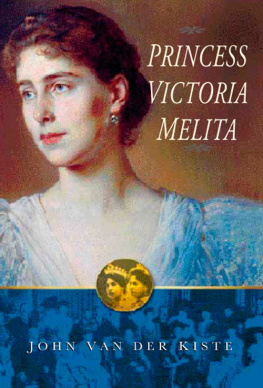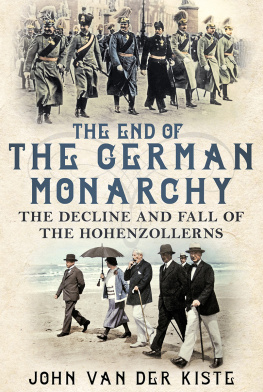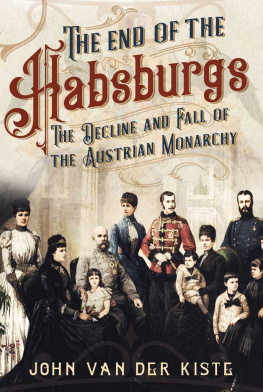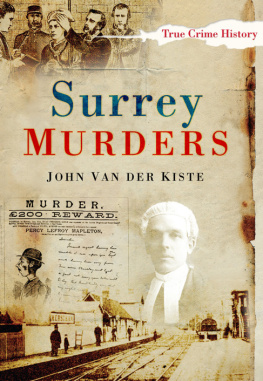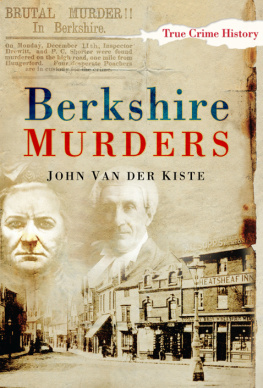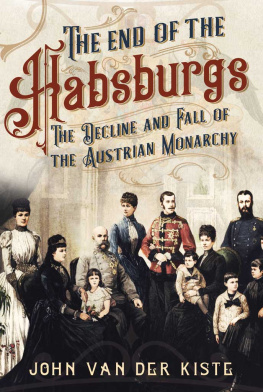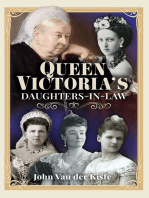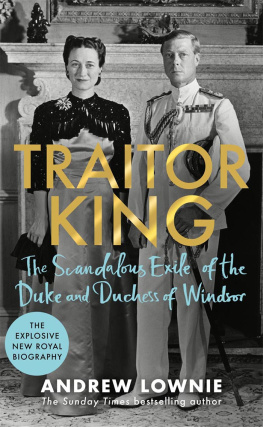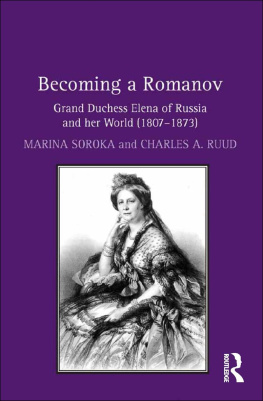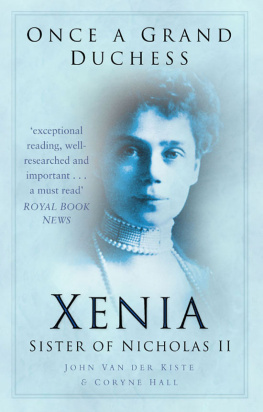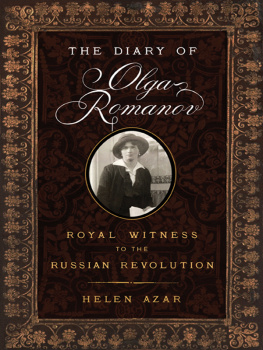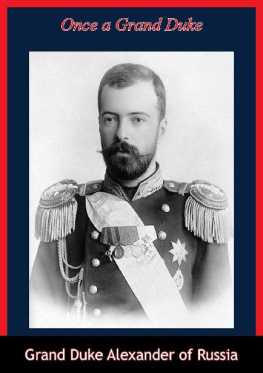P RINCESS V ICTORIA M ELITA
P RINCESS V ICTORIA M ELITA
G RAND D UCHESS C YRIL OF RUSSIA 1876 1936
J OHN V AN DER K ISTE
First published in 1991
This paperback edition first published in 2003
The History Press
The Mill, Brimscombe Port
Stroud, Gloucestershire, GL 5 2 QG
www.thehistorypress.co.uk
This ebook edition first published in 2011
All rights reserved
John Van der Kiste, 1991, 2003, 2011
The right of John Van der Kiste, to be identified as the Author of this work has been asserted in accordance with the Copyrights, Designs and Patents Act 1988.
This ebook is copyright material and must not be copied, reproduced, transferred, distributed, leased, licensed or publicly performed or used in any way except as specifically permitted in writing by the publishers, as allowed under the terms and conditions under which it was purchased or as strictly permitted by applicable copyright law. Any unauthorised distribution or use of this text may be a direct infringement of the authors and publishers rights, and those responsible may be liable in law accordingly.
EPUB ISBN 978 0 7524 7194 5
MOBI ISBN 978 0 7524 7193 8
Original typesetting by The History Press
Contents
Note to revised edition
T his book was first published in 1991. A paperback edition three years later gave me a chance to record the death in April 1992 of the Grand Duchesss youngest child, Grand Duke Vladimir. Since then, the release to historians and biographers of a vast amount of unpublished material pertaining to the Romanovs has resulted in the publication of several more biographies and accounts of the dynasty, and I have been happy to take advantage of these while revising this edition. Among those which deserve special mention are A Lifelong Passion: Nicolas and Alexandra, their own story, edited by Andrei Maylunas & Sergei Mironenko, and Little Mother of Russia: A biography of Empress Marie Feodorovna, by Coryne Hall.
I would also like to acknowledge my considerable debt to Kim-Elisabeth Geldard, Coryne Hall, Karen Roth, Sue Woolmans and Ian Shapiro; and dedicate this volume to the memory of Theo Aronson.
Foreword
O f Queen Victorias twenty-two granddaughters, none apart from those who were destined to become Queens or Empresses themselves had such a colourful life as Princess Victoria Melita of Edinburgh, who became successively Grand Duchess Ernest Louis of Hesse and the Rhine, and later Grand Duchess Cyril Vladimirovich of Russia.
Unlike so many of her contemporaries, however, her life has never been fully documented, or given the distinction of an individual biography. She does not appear to have kept a journal; if so, none has survived. At the best of times, she was an erratic letter writer, as Queen Victoria (an indefatigable correspondent herself) was moved to complain on more than one occasion. Even more frustratingly, it has proved impossible to obtain access to more than a very small amount of her surviving correspondence.
Moreover, unlike both her husbands and her favourite sister Marie, Queen of Roumania, she never wrote or published any memoirs. While their reminiscences have proved useful sources for her life, inevitably they have tended to overshadow her life and times a fascinating life that began in Malta, to a childhood divided between England, Scotland and Germany, to a married life that took her to Germany, France and Russia, and finally a dignified if hardly serene exile in post-war Finland, Germany and Brittany.
After the Russian revolution in 1917 and the collapse of imperial power, Grand Duchess Cyril seems to have been regarded as less important. Her name features but rarely in official records, or in The Times. Her activities during her last twenty years have been the subject of much speculation and gossip, often conflicting, ever since. Most people who still remember her, or who know those who can remember meeting her, are reluctant to talk about certain areas of her life, and matters such as her feelings towards the burgeoning Nazi movement are the subject of considerable disagreement.
At the risk of inconsistency, first names used throughout the text are those most commonly used in English, though they may appear in a different form when quoted in letters; for instance, Grand Duke Cyril was sometimes referred to in correspondence as Kyrill or Kirill, and where letters are used in the book the spelling remains unaltered.
I wish to acknowledge the gracious permission of Her Majesty The Queen to publish certain material of which she owns the copyright.
I am also indebted to the Hon. David Astor, by whose permission certain extracts from the correspondence of his mother, Lady Astor, to Her Majesty Queen Marie of Roumania, are published here for the first time, and to the staff, Department of Archives and Manuscripts, Reading University, for access to the material; and to Edward Voules, for permission to quote from his privately printed work Free of All Malice.
Several people have been extremely generous with their time, their advice, and with asking other people for information. In particular, the late Mrs Bee Jordaan and John Wimbles have not only read the draft manuscript at various stages and saved me from several small factual errors, but have also been exceptionally helpful in tracking down elusive, not to say hitherto-unknown, sources of information, and with discussing various aspects of Princess Victoria Melitas life and character. Without them, the book would have been very much harder to write; the end result is certainly very much the better for their participation.
Sadly, Bee died on 17 September 1990, shortly before this book went to press. Ever since collaborating on a biography of the Princesss father, Dearest Affie, published in 1984, we had considered this as a future project, and I regret that she did not live to see the final result. It is to her memory that the work is respectfully dedicated.
My thanks are also due to H.H. Prince Nicolas Romanoff; Arthur Addington; Theo Aronson; Dr Otto Hambrecht, Bayerisches Staatsarchiv, Coburg; Joyce Kilvington; Kathleen Marten, Kent State Library, Ohio, USA; Ricardo Mateos Sainz de Medrano; Aila Narva, National Archives, Helsinki, Finland; Robin Piguet; Bodil Sander, Det Kongelige Bibliotek, Copenhagen; Shirley Stapley; and, as ever, my parents, Wing Commander Guy and Nancy Van der Kiste, for their constant help, advice and encouragement during the writing of this biography.
1
The Duke and Duchess of Edinburgh
A swarm of European royalty descended on St Petersburg in January 1874 for the wedding of Prince Alfred, Duke of Edinburgh, to Marie, Grand Duchess of Russia. As befitted the nuptials of a daughter of the Tsar, it was a picturesque and magnificent occasion. No less remarkable were the circumstances leading up to the marriage themselves, for in view of the fragile relations between Britain and Russia during the nineteenth century, and even more so between their reigning dynasties, it was almost unthinkable that such a match could ever come to pass.
Prince Alfred (Affie) was born at Windsor Castle on 6 August 1844, the fourth child and second son of Queen Victoria and Prince Albert. In his formative years he compared favourably with his elder brother Prince Albert Edward (Bertie), Prince of Wales. While the son born to succeed his mother on the throne as King Edward VII was wilful, obstinate and given to fits of uncontrollable temper, Affie was a placid child. He was more eager to learn than his brother, and at the age of four and a half, according to his governess Lady Lyttelton, he was said to have very uncommon abilities; and a mind which will make the task of instructing him most smooth and delightful.1 His intelligence and powers of concentration were evident at an early age, as was his passion for geography and anything to do with the Royal Navy. He was clever with his hands, and enjoyed taking mechanical devices to pieces and reassembling them to find out how they worked, sometimes adding minor improvements of his own in the process. He also made toys for the younger children, and even a rudimentary musical box which played

